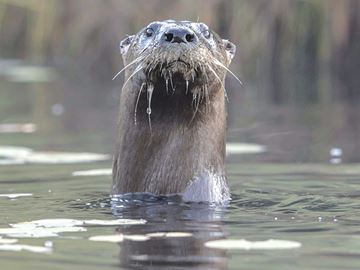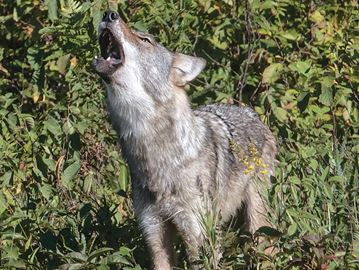Sometimes when you talk to reporters they can’t remember things if you say too much and you have to limit your comments to one or two key points and repeat them over and over. Sometimes they get the gist, but not the details. Sometimes you can just tell they’re waiting to talk to the next person and are sick of listening to you. But every now and then you run into a reporter that remembers EVERYTHING you said so you better not say it wrong. Richard Freedman of the Vallejo Times-Herald definitely falls into that last category, I now realize. (Hopefully I didn’t get myself in too much hot water with the otter folks!)

Beavers don’t get the great PR like otters. You know, eating off their tummies in the ocean. Stuff like that. Even beaver crusader Heidi Perryman shrugs, “Everyone loves otters. They’re cute and don’t build dams. I’m feeling jealousy how easy otters’ lives are.”
Yet, the beaver, those buck-toothed, paddle-tailed rodents, play an integral role in the food chain and the environment, says Perryman.
Those dams they build hold back water, sure, but it creates more bugs. Fish eat bugs. Birds eat fish. Beyond more wildlife, the beavers have conserve water and in a drought era, it’s vital, Perryman noted.
A child psychologist when she’s not lobbying for beavers, Perryman joins Kate Lundquist as speakers this Friday at the Empress Theatre for “Beaver Mania,” an evening that includes the film, “Leave it to Beavers” as part of the Visions of the Wild festival.
Well I can’t deny it. I do feel jealousy. Ha!
Not only was the beaver saved in Martinez, it’s become the star of a huge mural and an annual summer beaver festival as Perryman created a nonprofit, “Worth a Dam,” with a website, martinezbeavers.org/wordpress.
“I really wanted to persuade people not to kill the beaver. I didn’t expect to become an expert,” Perryman said. “I’m an accidental beaver advocate.”
It shouldn’t be surprising that beavers even live in Vallejo, said Perryman.
“We’re constantly expanding. We’re growing into places where they used to be and that’s not going to change,” she said. “At the same time, their population is recovering.”
Though humans may be concerned that beavers could overrun an area, it’s not likely to happen, Perryman said.
“Beavers are territorial. They don’t want to live around each other,” she said. “If one family has moved in, another will go off to look for unchartered territory and sometimes that’s an urban stream with a low gradient, trees on it, and nobody usually goes there.”
It’s interesting to me that one could look through the evolution of my beaver advocacy like analyzing the layers of stratification in soil and see where I crossed paths with a new teacher who taught me something I wanted to retain. Like the term “low gradient” applied to urban streams (from Greg Lewallen when we worked on the urban beaver paper) or the upcoming section on beaver resilience (from Leonard Houston’s address at the last State of the Beaver conference). I guess sometimes I listen too.
Beavers, continued Perryman, are a resilient bunch.
“They were the first animals after Mount St. Helens eruption (1980). And one of the first species after Chernobyl (nuclear explosion 1986),” said Perryman. “They have a lot of adaptive ability, so they’re coming to a city near you so we may as well learn how to deal with them.”
“Leave it to Beavers,” a 53-minute documentary by Jari Osbourne, “is a great movie,” Perryman said. “I know people will leave the theater thinking, ‘Beavers do a lot of things I didn’t know.’”
Visions of the Wild runs through Sept. 18, including “Beaver Mania!’ 7 to 10 p.m. Friday, Empress Theatre, 330 Virginia St., Vallejo. Free. Discussions and documentary, “Leave it to Beavers.” For more, visit visionsofthewild.org.
I’m pretty happy with this article, and starting to get excited about the event. Solano county received its share of depredation permits in the last three years so I’d love to teach them something new about beavers. The theater is a lovely old restored venue and it will be really fun to watch our beavers and Jari’s documentary on the big screen.
Are you coming?

 I was recently privileged to travel to north central WA State to train Okanogan County Highway personnel how to coexist with beavers. My thanks go to the Methow Beaver Project’s (MBP) Kent Woodruff and Julie Nelson for working to arrange it. We installed trapezoidal culvert fences at a couple of sites the County had been battling beavers at for some time.
I was recently privileged to travel to north central WA State to train Okanogan County Highway personnel how to coexist with beavers. My thanks go to the Methow Beaver Project’s (MBP) Kent Woodruff and Julie Nelson for working to arrange it. We installed trapezoidal culvert fences at a couple of sites the County had been battling beavers at for some time. Kent, Julie and Josh Thomson (County Highway Engineer) were instrumental in the planning and execution of these two projects. I was very impressed with the County Highway workers and of course the MBP personnel who jumped right in the water to help construct these flow devices.
Kent, Julie and Josh Thomson (County Highway Engineer) were instrumental in the planning and execution of these two projects. I was very impressed with the County Highway workers and of course the MBP personnel who jumped right in the water to help construct these flow devices.








 A Beaver slapped its tail, informing me that the dark animals had entered its space. Moments later, four Otters came snorting and huffing past my canoe, sticking their heads out of the water like giant periscopes to get a better view of me.
A Beaver slapped its tail, informing me that the dark animals had entered its space. Moments later, four Otters came snorting and huffing past my canoe, sticking their heads out of the water like giant periscopes to get a better view of me. onts, the beautiful animal walked away, content that the impudent intruder was not going to cross the pond.
onts, the beautiful animal walked away, content that the impudent intruder was not going to cross the pond.










































